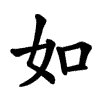Definify.com
Definition 2025
鼎
鼎
Translingual
| Stroke order | |||
|---|---|---|---|

| |||
Han character
鼎 (radical 206 鼎+0, 13 strokes, cangjie input 月山女一中 (BUVML), four-corner 22221)
- Kangxi radical #206, ⿍ (“tripod”).
References
- KangXi: page 1525, character 8
- Dai Kanwa Jiten: character 48315
- Dae Jaweon: page 2060, character 20
- Hanyu Da Zidian: volume 7, page 4740, character 1
- Unihan data for U+9F0E
Chinese
|
simp. and trad. |
鼎 | |
|---|---|---|
Glyph origin
| Historical forms of the character 鼎
| |||
|---|---|---|---|
| Oracle bone script | Bronze inscriptions | Large seal script | Small seal script |
 |
 |
 |
 |
| Characters in the same phonetic series (鼎) (Zhengzhang, 2003) | |
|---|---|
| Old Chinese | |
| 鼎 | *kleːŋʔ |
| 薡 | *teːŋʔ |
| 濎 | *teːŋʔ |
Pictogram (象形) .
Pronunciation
- Mandarin
- Cantonese (Jyutping): ding2
- Hakka (Sixian, PFS): tín
- Min Dong (BUC): diāng / dīng
- Min Nan (POJ): tiáⁿ / téng
- Wu (Wiktionary): tin (T2)
- Mandarin
- (Standard Chinese, Beijing)+
- Pinyin:
- Zhuyin: ㄉㄧㄥˇ
- Wade-Giles: ting3
- Gwoyeu Romatzyh: diing
- IPA (key): /tiŋ²¹⁴/
- (Standard Chinese, Beijing)+
- Cantonese
- (Standard Cantonese, Guangzhou)+
- Jyutping: ding2
- Yale: díng
- Cantonese Pinyin: ding2
- IPA (key): /tɪŋ³⁵/
- (Standard Cantonese, Guangzhou)+
- Hakka
- (Sixian, incl. Miaoli and Meinong)
- Pha̍k-fa-sṳ: tín
- Hakka Romanization System: din`
- Hagfa Pinyim: din3
- IPA: /tin³¹/
- (Sixian, incl. Miaoli and Meinong)
- Min Dong
- (Fuzhou)
- Bàng-uâ-cê: diāng / dīng
- IPA (key): /tiaŋ³³/, /tiŋ³³/
- Note: diāng - vernacular; dīng - literary.
- (Fuzhou)
- Min Nan
- (Hokkien)
- Pe̍h-ōe-jī: tiáⁿ / téng
- Tâi-lô: tiánn / tíng
- Phofsit Daibuun: dviar, deang
- IPA (Xiamen): /tiã⁵³/, /tiɪŋ⁵³/
- IPA (Quanzhou): /tiã⁵⁵⁴/, /tiɪŋ⁵⁵⁴/
- IPA (Zhangzhou): /tiã⁵³/, /tiɪŋ⁵³/
- IPA (Taipei): /tiã⁵³/, /tiɪŋ⁵³/
- IPA (Kaohsiung): /tiã⁴¹/, /tiɪŋ⁴¹/
- Note: tiáⁿ - vernacular; téng - literary.
- (Hokkien)
- Wu
- (Shanghainese)
- Wiktionary: tin (T2)
- IPA (key): /tɪɲ³⁴/
- (Shanghainese)
| Rime | |
|---|---|
| Character | 鼎 |
| Reading # | 1/1 |
| Initial (聲) | 端 (5) |
| Final (韻) | 青 (125) |
| Tone (調) | Rising (X) |
| Openness (開合) | Open |
| Division (等) | IV |
| Fanqie | 都挺切 |
| Reconstructions | |
| Zhengzhang Shangfang |
/teŋX/ |
| Pan Wuyun |
/teŋX/ |
| Shao Rongfen |
/tɛŋX/ |
| Edwin Pulleyblank |
/tɛjŋX/ |
| Li Rong |
/teŋX/ |
| Wang Li |
/tieŋX/ |
| Bernard Karlgren |
/tieŋX/ |
| Expected Mandarin Reflex |
dǐng |
| Zhengzhang system (2003) | |
|---|---|
| Character | 鼎 |
| Reading # | 1/1 |
| No. | 2415 |
| Phonetic component |
鼎 |
| Rime group |
耕 |
| Rime subdivision |
0 |
| Corresponding MC rime |
頂 |
| Old Chinese |
/*kleːŋʔ/ |
Definitions
鼎
- ding (ancient large, three-legged bronze cauldron for cooking or sacrificial rituals)
- (figuratively) throne; monarchy
- (figuratively, historical) important figures in the government
- (figuratively) big; great
- (figuratively) tripartite balance of forces
- (historical) ancient instrument of torture
- (literary) just (at this time); meanwhile
- (Min) wok; pot
- 50th hexagram of the I Ching
- A surname.
Compounds
Derived terms from 鼎
|
|
Japanese
Kanji
鼎
(“Jinmeiyō” kanji used for names)

鼎 (kanae, tei): ceremonial tripod kettle
Readings
Etymology 1
| Kanji in this term |
|---|
| 鼎 |
|
かなえ Jinmeiyō |
| kun'yomi |
Originally a compound of 金 (kana, “metal”) + 瓮 (he, “a pot or pan for holding food or beverages”).[1][2]
Pronunciation
Alternative forms
- 釜 (less common)
Noun
鼎 (hiragana かなえ, romaji kanae, historical hiragana かなへ)
- a three-legged kettle, a tripod kettle, used for cooking and later for ceremonial purposes in ancient China, and often made of bronze
- a symbol of a king or other high authority
Idioms
- 鼎の軽重を問う (kanae no keijū o tō): "to ask about the weight of a kettle" ⇒ to question a person's ability
- 鼎の沸くが如し (kanae no waku ga gotoshi): "just like a boiling kettle" ⇒ a metaphor for a noisy busy situation
- 鼎の中の一切れの肉 (kanae no naka no hitokire no niku): "single slice of meat [from] in the kettle" ⇒ to get a read on the whole from a small sample
- 鼎を扛ぐ (kanae o agu): "to lift a kettle" ⇒ to be physically strong
- 鼎を定む (kanae o sadamu): "to settle the kettle" ⇒ to control the imperial capital, to ascend the throne
Etymology 2
| Kanji in this term |
|---|
| 鼎 |
|
てい Jinmeiyō |
| on'yomi |
From Middle Chinese 鼎 (*děng). Compare modern Mandarin 鼎 (dǐng).
Pronunciation
Noun
- a three-legged kettle, a tripod kettle, used for cooking and later for ceremonial purposes in ancient China, and often made of bronze
- one of the I Ching hexagrams
References
- ↑ 1988, 国語大辞典(新装版) (Kokugo Dai Jiten, Revised Edition) (in Japanese), Tōkyō: Shogakukan
- 1 2 3 2006, 大辞林 (Daijirin), Third Edition (in Japanese), Tōkyō: Sanseidō, ISBN 4-385-13905-9
- ↑ 1997, 新明解国語辞典 (Shin Meikai Kokugo Jiten), Fifth Edition (in Japanese), Tōkyō: Sanseidō, ISBN 4-385-13143-0
Korean
Hanja
鼎 • (jeong) (hangeul 정, revised jeong, McCune-Reischauer chŏng, Yale ceng)
- This term needs a translation to English. Please help out and add a translation, then remove the text
{{rfdef}}.
Vietnamese
Han character
鼎 (đỉnh, đềnh, đểnh, đễnh)
- This term needs a translation to English. Please help out and add a translation, then remove the text
{{rfdef}}.